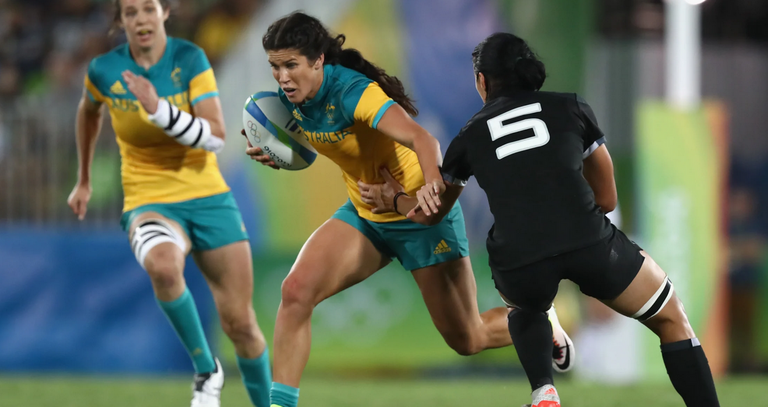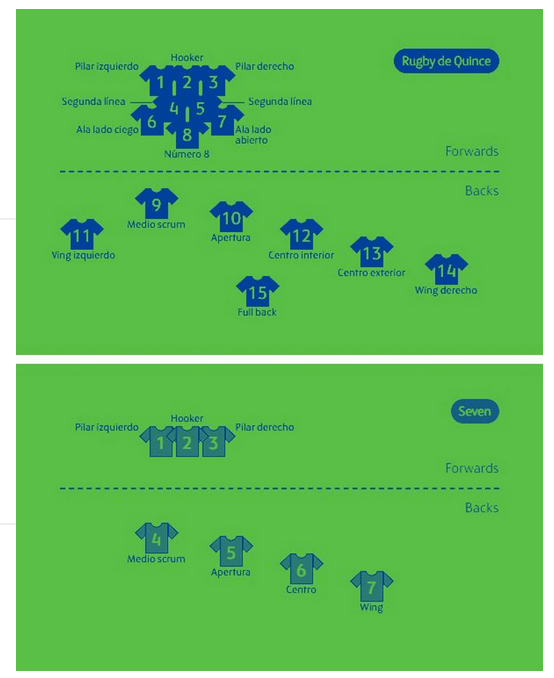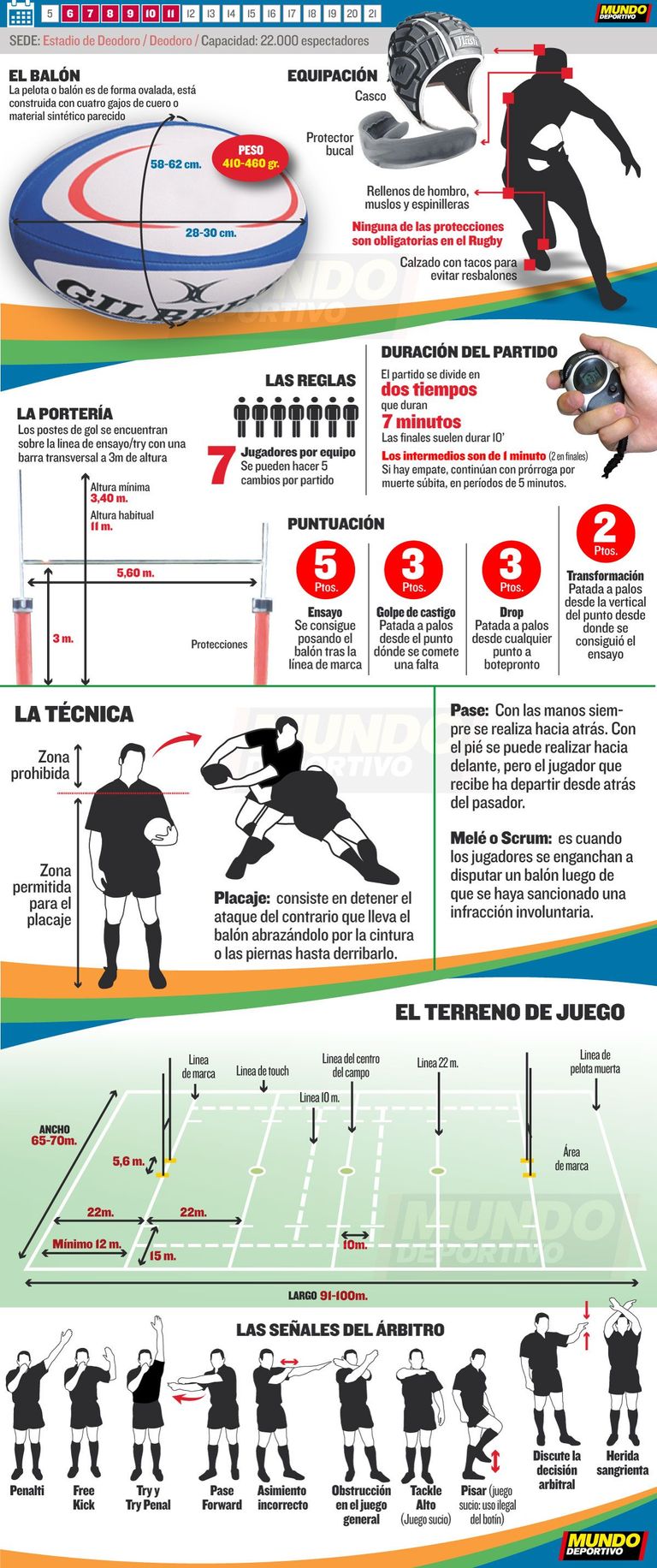
Uno de los deportes nuevos en los Juegos Olímpicos (fue incorporado en Rio 2016) es el rugby.
Como otros deportes, excluídos sin una razón aparente de los Juegos, fue finalmente aceptado como una disciplina olímpica a pacto que fuera una disciplina distinta del rugby tradicional. Una actitud poco entendible de parte del COI, como tantas otras.
Habría que sugerirle a la gente que maneja el ajedrez a nivel internacional (la Federación Internacional de Ajedrez)para que hagan algo similar. Tal vez de esa manera podría ser incorporado a los Juegos. Todo es posible en un mundo moderno donde, a veces, las explicaciones no se dan. Y los justificativos tampoco.
O al golf, olímpico en París 1900 y San Luis 1904 reapareciendo después de más un siglo en Rio 2016.
Rio de Janeiro significó un punto de quiebre en el "tradicionalismo olímpico". Y eso es positivo. Muy positivo. Ojalá siga esa tendencia.
Qué mejor que ver en los Juegos Olímpicos representados (casi) todos los deportes. O al menos aquellos que se practican en forma organizada en la mayor parte del mundo?

One of the new sports in the Olympic Games (it was incorporated in Rio 2016) is rugby.
Like other sports, excluded for no apparent reason from the Games, it was finally accepted as an Olympic discipline unless it was a different discipline from traditional rugby. A not very understandable attitude on the part of the IOC, like so many others.
It should be suggested to the people who manage chess at international level (the International Chess Federation) to do something similar. Maybe that way it could be incorporated into the Games. Everything is possible in a modern world where, sometimes, explanations are not given. And neither are the justifications.
Or golf, Olympic in Paris 1900 and St. Louis 1904, reappearing after more than a century in Rio 2016.
Rio de Janeiro marked a turning point in "Olympic traditionalism". And that is positive. Very positive. Let's hope this trend continues.
What could be better than to see (almost) all sports represented in the Olympic Games. Or at least those that are practiced in an organized way in most of the world?
Pero no nos alejemos del contenido del post y sigamos con el Rugby Seven. Un rugby con menos jugadores -menos de la mitad-, más espacios y jugadas veloces y espectaculares.
Uno de los motivos de su difusión es su espectacularidad. Si hay un aspecto que al rugby "aburrido" -disculpen los apasaionados de este deporte el uso de est término, pero es para aportar un poco de claridad al tema- es la gran candidad de jugadores -treinta- reunidos en el campo de juego.
Ya que el fútbol es un deporte super popular y cuyas reglas conoce todo el mundo hagamos una simple comparación: imaginemos un partido de fútbol con 30 jugadores. Habría muy pocos espacios para jugar y se haría más monótona.
Ese es el aspecto atrativo del Rugby Seven. Pocas "montoneras", scrum liviano de poco empuje, salida rápida, mucho traslado del balón, velocidad y espacios. En efecto, a diferencia, de los "colosos" que a veces vemos en el rugby tradicional -cercanos a los 100 kgs o más- en el rugby seven los jugadores son más ágiles porque es ahí -en la velocidad y no empujando- donde pueden hacer la diferencias.
Los tries son puntos logrados efectivamente por conversiones de jugadores lanzados en velocidad o no por lanzamientos o penales como ocurre en el rugby tradicional donde a veces se gana un partido sin haber convertido un solo try.
En un terreno de juego que tiene las mismas dimensiones que el rugby tradicional. Por eso vemos corridas espectacular y tries mucho más atractivos.
Todo esto ha hecho al Rugby Sven popular. Y también lo ha hecho desembarcar en los Juegos Olímpicos.
Por este motivo un deporte que no es nuevo (los inicios se remontan a fines del siglo XVIII cuando el escocés Ned Haig lo "inventa" para conseguir fondos del club que administraba) ha logrado reunir tantos seguidores a nivel mundial.


But let's not move away from the content of the post and let's continue with Rugby Sevens. A rugby with fewer players -less than half-, more spaces and fast and spectacular plays.
One of the reasons for its diffusion is its spectacular nature. If there is one aspect that makes rugby "boring" -apologies to those who are passionate about this sport for using this term, but it is to bring a little clarity to the subject- it is the large number of players -thirty- gathered on the field of play.
Since soccer is a super popular sport and its rules are known to everyone, let's make a simple comparison: imagine a soccer game with 30 players. There would be very few spaces to play and it would become monotonous.
That is the attractive aspect of Rugby Sevens. Few "packs", light scrum with little thrust, quick start, a lot of ball transfer, speed and spaces. Indeed, unlike the "giants" that we sometimes see in traditional rugby - close to 100 kgs or more - in rugby sevens players are more agile because it is there - at speed and not pushing - where they can make the difference.
Tries are points actually scored by players converted at speed and not by kicks or penalties as happens in traditional rugby where sometimes a game is won without having converted a single try.
On a field of play that has the same dimensions as traditional rugby. That is why we see spectacular runs and much more attractive tries.
All this has made Sven Rugby popular. And it has also brought it to the Olympic Games.
For this reason a sport that is not new (the beginnings date back to the late eighteenth century when the Scotsman Ned Haig "invented" it to raise funds for the club he managed) has managed to gather so many followers worldwide.
Evolución del Rugby Seven. / Evolution of Rugby Sevens.

A pesar de lo expresado en el párrafo anterior acerca de se creación como deporte el Rugby Seven es oficialmente un siglo más tarde, en la década del 70 cuando se disputa el primer encuentro entre selecciones, obviamente en Escocia.
Veinte años más tarde sobre el final del siglo XX se juega la primera Copa del Mundo de Rugby 7 en 1993 que luego dará origen seis años más tarde, en 1999, a la primera Copa del Mundo.
La parte femenina de esta disciplina tyarda un poco más en decolar y lo hace en Hong Kong en las postrimerías del segundo milenio (1997) con la organización del primer mundial femenino de Rugby Seven en el 2009.

In spite of what was expressed in the previous paragraph about its creation as a sport, Rugby Sevens was officially created a century later, in the 70's, when the first match between national teams was played, obviously in Scotland.
Twenty years later, at the end of the 20th century, the first Rugby 7's World Cup was played in 1993, which gave rise six years later, in 1999, to the first World Cup.
The women's side of this discipline took a little longer to take off and did so in Hong Kong at the end of the second millennium (1997) with the organization of the first women's Rugby Sevens World Cup in 2009.
Aspecto reglamentario. / Regulatory aspect.

En la imagen que ilustra la parte final de este comentario podemos ver muy bien resumidas las principales características de este juego, que al estar expresadas bajo la forma de una infográfica resulta mucho más atractiva visualmente.
El campo de juego es igual al del rugby de 15 jugadores: 100 m de largo por 70 m de ancho.
Lo mismo la meta (llamada "H" en rugby por la forma en que están dispuestos los palos) y el sistema de puntuación: 5 puntos por cada try más dos puntos agregados por la conversión del tiro libre.
Lo más notable y diferenciativo con su "hermano mayor" es el tiempo de juego: 14 minutos netos dvidido en dos mitades con un intervalo de descanso de 2 minutos (recordemos que en el rugby el reloj se detiene cuando el balón no está en movimiento). Por este motivo se pueden disputar hasta dos partidos por día y se armoniza perfectamente con la seguidilla de partidos de una Olimpíada.
Pases (siempre hacia atrás), patadas (al balón, entendámosnos, en el buen sentido de la palabra, siempre para delante), penalidades, placajes para detener al rival, son los mismos que en el rugby de quince.
Pero, a diferencia de aquel, una expulsión por ejemplo por tackl alto, puede ser devastadora. No es lo mismo que un equipo de 15 quede con 14 jugadores que un equipo de 7 jugadores siga jugando con 6.
Es lo que le pasó a Argentina en estos Juegos en su partido contra Sudáfrica (los famosos Springbooks) cuando debido a la expulsión de Gastón Revol a poco de iniciado el partido se vio obligada a jugar el resto del encuentro con un 6 jugadores. Que fueron 5 porque a minutos del final fue exoulsado otro jugador más sin posibilidad de volver a entrar al campo de juego. Por este motivo los medios resaltar este triunfo como épico. De estar 7 a 0 abajo pasó a estar 19-7 arriba terminadndo por ganar el encuentro 19 a 14.

In the image that illustrates the final part of this commentary we can see very well summarized the main characteristics of this game, that being expressed in the form of an infographic is much more visually appealing.
The playing field is the same as that of 15-a-side rugby: 100 m long by 70 m wide.
The same applies to the goal (called "H" in rugby because of the way the sticks are arranged) and the scoring system: 5 points for each try plus two points added for the conversion of the free kick.
The most notable difference with its "big brother" is the playing time: 14 net minutes divided into two halves with a rest interval of 2 minutes (remember that in rugby the clock stops when the ball is not in motion). For this reason, up to two matches can be played per day and it harmonizes perfectly with the sequence of matches in an Olympiad.
Passing (always backwards), kicking (to the ball, in the good sense of the word, always forwards), penalties, tackles to stop the opponent, are the same as in the rugby fifteen.
But, unlike that, an expulsion, for example for high tackling, can be devastating. It is not the same for a team of 15 to be left with 14 players as it is for a team of 7 to continue playing with 6.
This is what happened to Argentina in these Games in their match against South Africa (the famous Springbooks) when, due to the expulsion of Gaston Revol shortly after the start of the match, they were forced to play the rest of the match with 6 players. That was 5 because minutes before the end another player was sent off without the possibility of reentering the field of play. For this reason, the media highlighted this victory as epic. From being down 7 to 0, they went from being down to being 19-7 up and ended up winning the game 19 to 14.



Los enlaces de mis sitios web/Links to my websites:
Parcial o totalmente pueden encontrar este post reproducido en algunos de mis blogs y/o Webs de los cuales generalmente tomo nota para elaborar los contenidos en #BLURT.
Partially or totally you can find this post reproduced in some of my blogs and/or Webs of which I usually take note to elaborate the contents in #BLURT.

Upvoted. Thank You for sending some of your rewards to @null. Read my last posts to make sure that BLURT burning is profitable for you. Before using this bot please make sure your account has at least 100 BP. Get more BLURT:
@ mariuszkarowski/how-to-get-automatic-upvote-from-my-accounts@ blurtbooster/blurt-booster-introduction-rules-and-guidelines-1699999662965@ nalexadre/blurt-nexus-creating-an-affiliate-account-1700008765859@ kryptodenno - win BLURT POWER delegationNote: This bot will not vote on AI-generated content
Thanks @ctime and curators!